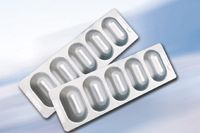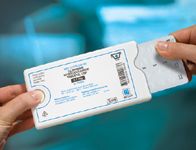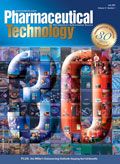Innovations Enable Packaging to Play Many Roles
Drug packaging performs functions such as ensuring patient well-being, providing information, preventing tampering, blocking counterfeiting, and improving compliance. Since 1977, packaging innovations have occurred in four major categories. The author provides an overview of major packaging improvements that have emerged in the past 30 years.
Without packaging, it would be virtually impossible to deliver pharmaceutical products to patients. Packaging helps protect, contain, carry, dispense, and sell pharmaceuticals. It also helps drug manufacturers educate and motivate consumers.
Over the years, pharmaceutical packaging has experienced many changes. Innovations have come in four categories: design, materials and containers, equipment, and logistics. Some advances involve more than one category.

Barrier packaging increasingly relies on new materials or combinations of materials. For maximum protection of moisture-sensitive pharmaceuticals, Alcan Packaging Singen GmbH (Singen, Germany) incorporates a desiccant in the seal layer of its "Formpack with Desiccant" foil laminate.
Advances in design
Innovations in package design perform many functions. They prevent children from unwittingly taking dangerous doses of medication, improve seniors' access to pharmaceuticals, protect consumers from malicious tampering, reduce medication errors, simplify adherence to dosage regimens, and educate consumers about the benefits and risks of drugs.
Before the passage of the Poison Prevention Packaging Act (PPPA) in 1970, an appalling number of toddlers were sickened or died because they accidentally ingested toxic amounts of prescription drugs or aspirin. The PPPA mandated "special packaging" for these products that makes it difficult for a toddler to gain access to a harmful dose. In 1978, iron-containing supplements were added to the list of products that must have child-resistant (CR) packaging. CR packaging concepts include press-and-turn closures, squeeze-and-turn closures, and peel–push blisters.
The Consumer Product Safety Commission (CPSC, Washington, DC) credits CR packaging with saving an estimated 700 lives since PPPA took effect (1). The packaging had one major disadvantage, however. Many designs that were difficult for kids to open were hard for senior citizens with limited hand strength and dexterity to open. When CPSC noted a rising number of poisonings because a grandparent transferred his or her medication to a non-CR container or didn't reclose a CR container properly, the commission changed test protocols to ensure that CR packaging was also senior-friendly.

Milestone. 30 Years of Pharmaceutical Technology
Several senior-friendly designs have been introduced, but there's still room for improvement. According to the CPSC, "Almost one third of oral prescription drugs involved in accidental ingestions by children under five belongs to someone other than the child's immediate family such as grandparents and other older adults" (2).
In addition to preventing childhood poisonings, packaging helps ensure drug products have not been tampered with and are genuine. Tamper-evident (TE) packaging originated in 1982, when seven people died after ingesting poisoned "Tylenol" capsules. The case, which remains unsolved, resulted in regulations that require TE packaging for most over-the-counter (OTC) pharmaceuticals. Options include shrink bands and nonfoam inner seals with a distinctive identifying characteristic, closures with a breakable band, and blister cards. Rules require packaging to carry information about the TE feature so consumers know what to look for.
In 1986, poisoned "Excedrin" capsules caused more deaths, and packaging rules were changed to require two TE features for all capsule products. These features often entail sealing the capsules themselves and incorporating another feature such as a shrink band.

Pfizer's "Exubera," the world's first inhaled insulin, wouldn't be possible without packaging innovations that contain and dispense the powdered insulin.
Counterfeit pharmaceuticals have become a huge problem worldwide as well. In fact, most studies estimate that 10% of drugs in the global supply chain are counterfeit. According to the US Food and Drug Administration (Rockville, MD), "drug products with a high market value or that are high-priced or have high sales volume are more frequently subject to counterfeiting and diversion" (3).
Package design deters counterfeiters when it is distinctive, difficult to duplicate, and incorporates features such as holographic labels, microprinting, color-shifting ink, or radio-frequency identification (RFID).
Yet another way packaging enhances patient safety is by preventing medication mistakes. Simple design techniques such as color coding can flag crucial information such as dosage strength and administration method. The Association of Anaesthetists of Great Britain and Ireland (London) and three related organizations have developed guidelines for color coding self-labeled syringes used in critical-care areas to help identify drug and drug type at a glance.

The "Clonidine" wallet pack combines child-resistant, senior-friendly, and compliance features.
In addition, FDA has mandated unit-of-use barcoding on the packaging of prescription and OTC drugs dispensed in hospitals. The barcode carries the product's National Drug Code and may also include a lot number and expiration date. Scanning with a barcode reader identifies the product and provides an automated means to confirm that the correct dose is being given to the right patient at the proper time through the correct administration route. If patient wristband information and caregiver identification is scanned, the system also can help automate record keeping and billing (4).
More than half of all prescriptions are not taken correctly (5). Reasons include difficulty remembering when to take a dose and whether a dose was taken. Creatively printed blister cards and presentations like wallet packs arrange medication in an organized fashion. Patients who take their medicine on schedule tend to experience more positive outcomes and lower healthcare costs. Increased compliance also generates sales for pharmacies and drugmakers because it encourages the prompt refill of prescriptions and the restocking of OTC drugs in the medicine cabinet (6).
One example of a sophisticated compliance package is a CR, senior-friendly wallet pack for "Clonidine" from Mylan Pharmaceuticals Inc. (Morgantown, WV) and UDL Laboratories, Inc. (Rockford, IL). The package was recently recognized in an annual competition sponsored by the Healthcare Compliance Packaging Council (Falls Church, VA). The design features a plastic housing with a slide-out drawer that holds a push-through blister card with 30 tablets arranged in four rows. Pressing a button unlocks the drawer so it can be pulled out to grant access to the medication. Precisely registered printing on the blister card indicates when each dose should be taken ("Shellpak" compliance package, MeadWestvaco Healthcare Packaging, New York).

Item-level radio-frequency identification tagging is moving from pilot projects to daily use, especially for commonly counterfeited products. Shown here are item-level tags and a reader from Impinj, Inc. (Seattle, WA).
Advances in materials and containers
Material and container advances help make design innovations a commercial reality, ensure products are adequately protected to maintain potency until the end of their expected shelf lives, simplify administration, minimize the chances of mislabeling or misdosing, discourage counterfeiting, and reduce the environmental impact of packaging.
Various materials can protect a product's shelf life. New combinations that offer good protection or low cost appear on the market constantly. Some innovations rely on familiar barrier materials such as "Aclar," ethylene vinyl alcohol, and polyvinylidene chloride. Others such as cyclic olefin copolymer (COC) and cyclic olefin polymer (COP) are newcomers to the pharmaceutical industry (7). COC replaces barrier-coated polyvinyl chloride (PVC), is capable of 5-in. draws, and forms on the same tooling as PVC. COP is compatible with injection-molded containers and flexible packaging, provides compatibility with ethylene oxide and gamma sterilization, and contains extremely low residual-metals content.
Simulation software helps manufacturers optimize barrier properties. Some are strictly materials-based, others help with the structural design of the container or blister package. One integrated program for blister packaging enables exploration of the effects of tool geometry, film types, and process conditions before performing stability tests. The ability to estimate thickness distribution, surface area, and the permeability of thermoformed cavities reduces the need for expensive production-line trials and minimizes tooling costs ("Pentapharm BlisterPro" blister-design program, Klöckner Pentaplast of America, Inc., Gordonsville, VA).

The "KUKA KR5 Sixx CR" cleanroom robot from KUKA Robotics Corp. (Clinton Township, MI) integrates easily because of its tabletop design and small size. The device features six axes of motion, a 650-mm reach, a 5-kg payload capacity, and computer-based control. The unit is rated class 5 according to DIN EN ISO 14644-1 and class 100 according to US Federal Standard 209 E.
Products requiring maximum moisture protection may rely on desiccants. Although desiccants typically are inserted into the package by dropping a small pouch or canister into the container, today it's possible to integrate the water-vapor-absorbing material into a component of the container or the container itself. Simulation programs also can help fine tune desiccant specification ("SimulSorb" modeling service, Multisorb Technologies, Buffalo, NY).
Advances in inhaler design make it possible to abandon chlorofluorocarbon propellants and enable the development of dry-powder technology and products such as "Exubera" inhaled insulin (Pfizer Inc., New York).
Packaging also enables transdermal delivery. A transdermal patch essentially is a drug-impregnated, pressure-sensitive label designed to be applied to the body that allows an active ingredient to be absorbed through the skin.
The advent of the prefilled syringe has reduced the chance of mixing errors and contamination during preparation, and dose mismeasurement. It also simplifies self-injection, saves time for hospital personnel, eliminates needle reuse, and lessens the chance of needle-related injuries (prefilled syringes, Vetter Pharma-Turm, Inc., Yardley, PA).
Advances in equipment
Equipment advances have increased productivity and reduced costs by offering higher speeds, hygienic design, quick changeover, low manpower requirements, expedited validation, and automated record-keeping. In addition, many material and container advances such as prefilled syringes, blow–fill–seal containers, and transdermal products depend on highly customized machines because drug and package are inextricably linked.
Automation is also now applied to material handling and quality control in the form of an increased use of robots and machine vision. Robots have even moved into the cleanroom.
In some cases, the cleanroom itself is being replaced by isolator-equipped filling lines that enclose all critical areas and control the air quality and flow inside to maintain pristine conditions.
Advances in logistics
Once a drug product leaves the manufacturer, it faces a potentially hostile environment. Insulated packaging and refrigerants, and temperature monitoring devices such as time–temperature indicators and data loggers ensure the safe arrival of sensitive pharmaceuticals and vaccines.
Some of today's advanced temperature loggers are inexpensive enough to be used for a single trip. Other monitoring devices combine temperature logging with RFID technology.
Now moving from the pallet and case level to the item level, RFID tagging is most commonly being used to provide the product information needed to satisfy retailer mandates. RFID also can support the pedigree requirements being put in place by a growing number of states. Reading item-level RFID tags at each point in the supply chain helps prevent counterfeiting and diversion, authenticates products, identifies bottlenecks, and provides improved inventory control. RFID systems rely on a customized combination of tags, readers, and software to carry and capture the item-level data as products move through the supply chain.
What does the future hold?
Packaging innovations have done an outstanding job in improving compliance, preventing medication errors, and discouraging counterfeiting. These advancements ensure quality for the consumer, and improve productivity and reduce costs for drugmakers.
Development must continue on all fronts, however. Despite our best efforts, fewer than 50% of prescriptions are taken correctly, tens of thousands of medication errors occur each year, an estimated 10% of all drug products worldwide are counterfeit, and quality-control lapses serious enough to warrant a recall put consumers in jeopardy on a monthly, if not weekly basis.
Hallie Forcinio is Pharmaceutical Technology's "Packaging Forum" editor, 4708 Morningside Dr., Cleveland, OH 44109, tel. 216.351.5824, fax 216.351.5684, editorhal@cs.com
Where were you 30 years ago?
"I was working as a marketing communications assistant at an engineering and construction firm, living in my first apartment, and looking for a new job. I found a new job that led me to meet some nice people, including the man I eventually married, but was otherwise mostly awful. I spent my spare time editing a biannual newsletter for the Kappa Phi Club, an organization for Christian collegiate women."
References
1. Consumer Product Safety Commission, "Child Resistant Packaging Saves Lives," CPSC Document #5019, www.cpsc.gov/cpscpub/pubs/5019.html (accessed June 7, 2007).
2. CPSC, "Use Child-Resistant Containers," CPSC Document #5018, www.cpsc.gov/cpscpub/pubs/5018.html (accessed June 7, 2007).
3. US Food and Drug Administration, Prescription Drug Marketing Act—Pedigree Requirements under 21 CFR Part 203, Draft Compliance Policy Guide 160.900 (Rockville, MD, June 2006).
4. Hallie Forcinio, "Bar Coding Deadline Looms," Pharm. Technol. 29 (5), 42–46 (2005).
5. Holly Wagner, "One-on-One with Pharmacists Gives Patients Medication Advantage," Research News (Ohio State University, Columbus, OH), researchnews.osu.edu/archive/chudrug.htm (accessed June 7, 2007).
6. Hallie Forcinio, "Improved Blister Packaging Benefits Consumers, Caregivers, and Drug Makers," Pharm. Technol. 27 (9), 38–45 (2003).
7. Hallie Forcinio, "Interphex Showcases Packaging Innovations," Pharm. Technol. 31 (6), 42–47 (2007).

Drug Solutions Podcast: A Closer Look at mRNA in Oncology and Vaccines
April 30th 2024In this episode fo the Drug Solutions Podcast, etherna’s vice-president of Technology and Innovation, Stefaan De Koker, discusses the merits and challenges of using mRNA as the foundation for therapeutics in oncology as well as for vaccines.